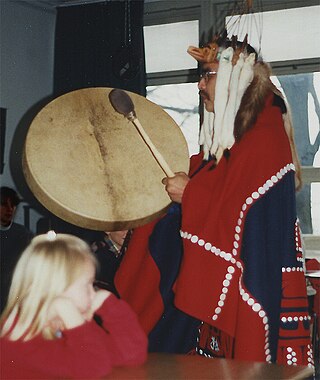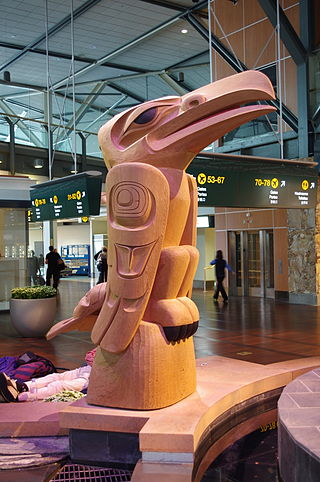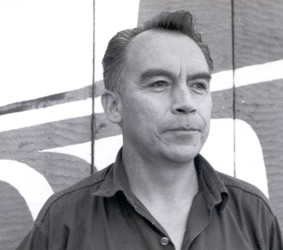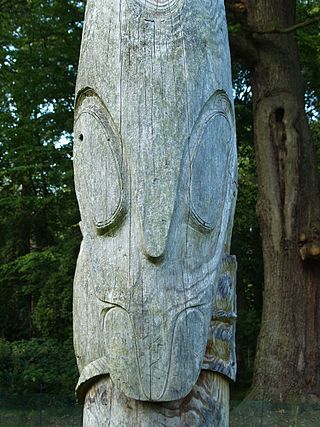Related Research Articles

Totem poles are monumental carvings found in western Canada and the northwestern United States. They are a type of Northwest Coast art, consisting of poles, posts or pillars, carved with symbols or figures. They are usually made from large trees, mostly western red cedar, by First Nations and Indigenous peoples of the Pacific Northwest Coast including northern Northwest Coast Haida, Tlingit, and Tsimshian communities in Southeast Alaska and British Columbia, Kwakwaka'wakw and Nuu-chah-nulth communities in southern British Columbia, and the Coast Salish communities in Washington and British Columbia.

The Kwakwa̱ka̱ʼwakw, also known as the Kwakiutl, are one of the indigenous peoples of the Pacific Northwest Coast. Their current population, according to a 2016 census, is 3,665. Most live in their traditional territory on northern Vancouver Island, nearby smaller islands including the Discovery Islands, and the adjacent British Columbia mainland. Some also live outside their homelands in urban areas such as Victoria and Vancouver. They are politically organized into 13 band governments.

Emily Carr was a Canadian artist who was inspired by the monumental art and villages of the First Nations and the landscapes of British Columbia. She also was a vivid writer and chronicler of life in her surroundings, praised for her "complete candour" and "strong prose". Klee Wyck, her first book, published in 1941, won the Governor General's Literary Award for non-fiction and this book and others written by her or compiled from her writings later are still much in demand today.

The Tsimshian are an Indigenous people of the Pacific Northwest Coast of North America. Their communities are mostly in coastal British Columbia in Terrace and Prince Rupert, and Metlakatla, Alaska on Annette Island, the only reservation in Alaska.

Haisla people are a First Nation who reside in Kitamaat. The Haisla consist of two bands: the Kitamaat people, residing in upper Douglas Channel and Devastation Channel, and the Kitlope People, inhabiting upper Princess Royal Channel and Gardner Canal in British Columbia, Canada.
Charles Noel van Sandwyk is a Canadian artist, illustrator and writer.
The Gispwudwada or Gisbutwada is the name for the Killerwhale "clan" (phratry) in the language of the Tsimshian nation of British Columbia, Canada, and southeast Alaska. It is considered analogous or identical to the Gisgahaast clan in British Columbia's Gitxsan nation and the Gisḵ'ahaast/Gisḵ'aast Tribe of the Nisg̱a'a. The Nisg̱a'a also call this group the Killerwhale Tribe, though the Gitxsan use the term Fireweed clan; Gisgahaast means literally "people of the fireweed."
Robert Charles Davidson, is a Canadian artist of Haida heritage. Davidson's Haida name is G̲uud San Glans, which means "Eagle of the Dawn". He is a leading figure in the renaissance of Haida art and culture. He lives in White Rock, British Columbia.

Dempsey Bob, is a Northwest Coast woodcarver and sculptor from British Columbia, Canada, who is of Tahltan and Tlingit First Nations descent. He was born in the Tahltan village of Telegraph Creek on the Stikine River in northwestern B.C., and is of the Wolf clan.
Bill Helin is a Canadian artist, illustrator, jewelry designer engraver, writer, tourism and branding expert, drumming specialist, singing and verbal storyteller; and logo and gift product designer in the Northwest Coast style and a member of the Tsimshian First Nation of northwestern British Columbia. His ancestry is from the Gits'iis tribe in the village of Lax Kw'alaams, B.C. His father was Arthur Helin-(pronounced Hel-een) (Haymaas), was a commercial fisherman and basketball star, was also in Chief lineage in the Gitlan tribe of the Tsimshian Nation.

George Hunt (Tlingit) was a Canadian and a consultant to the American anthropologist Franz Boas; through his contributions, he is considered a linguist and ethnologist in his own right. He was Tlingit-English by birth and learned both those languages. Growing up with his parents at Fort Rupert, British Columbia in Kwakwaka'wakw territory, he learned their language and culture as well. Through marriage and adoption he became an expert on the traditions of the Kwakwaka'wakw of coastal British Columbia.

Henry Hunt was a First Nations woodcarver and artist from the Kwakwaka'wakw people of coastal British Columbia. He carved a number of totem poles which are on public display in Canada and internationally.

Norman Tait was a Nisga'a First Nations sculptor and totem pole carver from northwestern British Columbia, Canada.
Harbour Publishing is a Canadian independent book publisher.
Summerwild Productions is a Canadian independent book publisher.

Arthur Vickers, OBC is a Canadian West Coast storyteller and artist. He received the Order of British Columbia in 2008 for his charitable work fundraising.

Beau Dick was a Kwakwaka'wakw Northwest Coast artist and Chief who lived and worked in Alert Bay, British Columbia, Canada. He was a contemporary artist, activist and hereditary Chief from the Namgis First Nation. Dick was an artist with an extensive national and international exhibition history.
Robert "Lucky" Budd is a Canadian author, oral historian, and radio host. He is known for his books based upon the stories of British Columbia pioneers, as well as his book collaborations with artist Roy Henry Vickers.
Simon Charlie or Hwunumetse' (1919–2005) was a Canadian totem sculptor of the Cowichan Tribes (Quw'utsun) of the Coast Salish nation, known for his wood carvings. He was born in Koksilah, on Vancouver Island, close to Duncan, British Columbia.

Stanley Clifford Hunt is a Canadian, First Nations Kwakiutl artist from British Columbia.
References
- ↑ admin (2002-12-28). "Referendum Ballots Go Out to BC Electorate". Firstnationsdrum.com. Retrieved 2017-07-12.
- ↑ [ dead link ]
- ↑ MacGregor, Roy (14 August 2016). "The story of the Fraser River: A 'symbol of life' that can also be violent and deadly". Hope, B.C.: The Globe and Mail. Retrieved 12 July 2017.
- ↑ Order of Canada citation